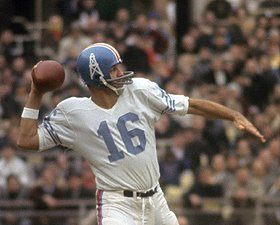But if you look closely, there was some attention being paid to old George Blanda, the Houston Oilers quarterback who set a new pro football record by throwing 68 passes in a losing effort against those Bills. You might be wondering how did a 37-year-old quarterback in 1964 get away with throwing 68 passes? At the time, the single-game record by pass attempts by a team or player was 60, set by Davey O’Brien with the Philadelphia Eagles back in 1940. In the ensuing 23-and-a-half seasons, no team had hit 60 pass attempts again, and then Blanda and the Oilers threw 68 times on November 1st, 1964. In the next 24 seasons, no quarterback threw more than 62 passes in a game.
So, what happened on November 1st 1964 in western New York?
Let’s begin with the opponent. Blanda had a lot of success against the Bills in 1963: in two wins, he completed 30 of 56 passes for 475 yards with 6 TDs and 1 interception, back when those numbers were truly outstanding. [continue reading…]


